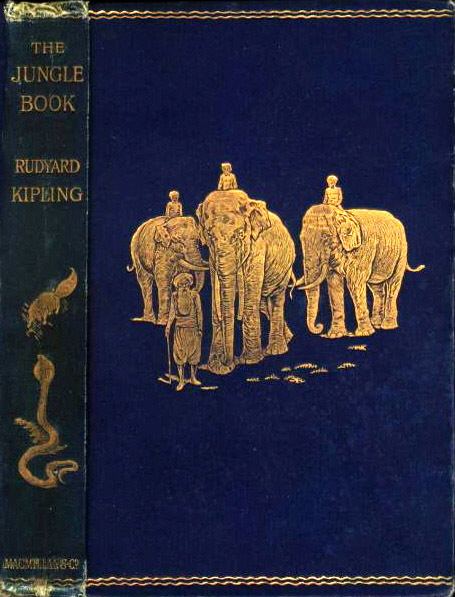Author Language English Genre Children's book | Country United Kingdom Series The Jungle Books | |
 | ||
Illustrator John Lockwood Kipling (Rudyard's father) | ||
The Jungle Book (1894) is a collection of stories by English author Rudyard Kipling. The stories are fables, using animals in an anthropomorphic manner to give moral lessons. A principal character is the boy or "man-cub" Mowgli, who is raised in the jungle by wolves. Other characters include Shere Khan the tiger and Baloo the bear. The book has been adapted many times for film and other media.
Contents
Context
The stories were first published in magazines in 1893–94. The original publications contain illustrations, some by the author's father, John Lockwood Kipling. Rudyard Kipling was born in India and spent the first six years of his childhood there. After about ten years in England, he went back to India and worked there for about six-and-a-half years. These stories were written when Kipling lived in Naulakha, the home he built in Dummerston, Vermont, in the United States. There is evidence that Kipling wrote the collection of stories for his daughter Josephine, who died from pneumonia in 1899, aged 6; a rare first edition of the book with a handwritten note by the author to his young daughter was discovered at the National Trust's Wimpole Hall in Cambridgeshire, England, in 2010.
Description
The tales in the book (as well as those in The Second Jungle Book, which followed in 1895 and includes five further stories about Mowgli) are fables, using animals in an anthropomorphic manner to teach moral lessons. The verses of "The Law of the Jungle", for example, lay down rules for the safety of individuals, families, and communities. Kipling put in them nearly everything he knew or "heard or dreamed about the Indian jungle". Other readers have interpreted the work as allegories of the politics and society of the time.
Origins
A letter written and signed by Rudyard Kipling in 1895 was put up for auction in 2013 by Andrusier. In this letter, Kipling confesses to borrowing ideas and stories in the Jungle Book: "I am afraid that all that code in its outlines has been manufactured to meet 'the necessities of the case': though a little of it is bodily taken from (Southern) Esquimaux rules for the division of spoils," Kipling wrote in the letter. "In fact, it is extremely possible that I have helped myself promiscuously but at present cannot remember from whose stories I have stolen."
Chapters
The book is arranged with a story in each chapter. Each story is followed by a poem that serves as an epigram.
Reception
Sayan Mukherjee, writing for the Book Review Circle, calls The Jungle Book "One of the most enjoyable books of my childhood and even in adulthood, highly informative as to the outlook of the British on their 'native population'."
The Jungle Book came to be used as a motivational book by the Cub Scouts, a junior element of the Scouting movement. This use of the book's universe was approved by Kipling at the request of Robert Baden-Powell, founder of the Scouting movement, who had originally asked for the author's permission for the use of the Memory Game from Kim in his scheme to develop the morale and fitness of working-class youths in cities. Akela, the head wolf in The Jungle Book, has become a senior figure in the movement; the name is traditionally adopted by the leader of each Cub Scout pack.
Books
Robert Heinlein got the idea for his science fiction novel, Stranger in a Strange Land (1961), when he and his wife, Virginia, were brainstorming one evening in 1948; she suggested a new version of Kipling's The Jungle Book (1894), but with a child raised by Martians instead of wolves, and he decided to go further with the idea and worked on the story on and off for more than a decade. In 1962, it received the Hugo Award for Best Novel.
Neil Gaiman's The Graveyard Book (2008) is inspired by The Jungle Book. It follows a baby boy who is found and brought up by the dead in a cemetery. It has many scenes that can be directly linked back to Kipling, but with Gaiman's dark twist. Mr. Gaiman has spoken in some detail about this on his website.
Audio
Comic books
The book's text has often been edited or adapted for younger readers, and there have been several comic book adaptations:
Films and television
Many motion pictures have been based on Kipling's stories:
Theatre
Stuart Paterson wrote a stage adaptation in 2004, first produced by the Birmingham Old Rep in 2004 and published in 2007 by Nick Hern Books.
